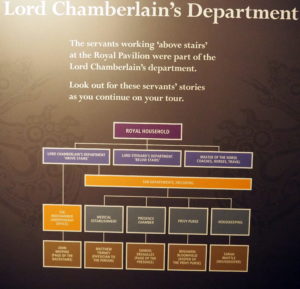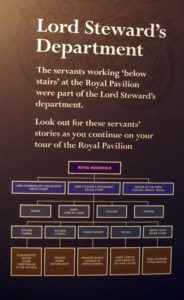Guests stayed for several days, but rarely longer than a week. They were often joined at dinner by others staying in the town. Dinner was served in the banqueting room at six and was followed by conversations, games or musical entertainment. This could often last until the early hours.
The Prince did not join his guests for breakfast, who had the option of breakfasting in their rooms or sharing a meal in the first floor galleries.
Household management was shared between three departments, headed by an Officer of the State. The Office of Woods and Forests was responsible for the fabric of the building, structural alterations and the exterior.
The Lord Chamberlain’s Office was responsible for interior decoration, refurbishment and management of the servants. The Lord Stewart’s Office was responsible for the kitchens, gardens and supply of food, fuel, and staff involved in these areas. There was some overlap of responsibilities.
George paid his staff quite well by the standards of the day. Staff were paid quarterly and received allowances for clothing and lodgings. Pensions to retired members were generous.
A small skeleton staff were kept on for the full year, although most staff arrived with George at the start of his winter visit. The quality of accommodation depended on rank and space available.
Public rooms had luxurious wall to wall carpets, specially designed for each room. Servant areas had hard wearing drugget oil cloth coverings.
Water closets were provided through out the Pavilion with water pumped from the well by a forcing engine in a tower in the courtyard. Panels hid the pipes. Most bedrooms also had a chamber pot. The King’s bedroom had a bidet chair. The King also had his own bathroom, now demolished with a plunge bath fed by a supply of fresh as well as sea water. This was pumped from the sea into a tank in the gardens. A boiler heated the water.
Lighting played a key role and was crucial in creating a dramatic atmosphere
Many first floor areas had painted glass skylights. Crystal chandeliers were designed to complement the different rooms. The most impressive is that in the banqueting room. At night rooms were lit by a combination of candles and oil lamps . Smoke caused damage to paint work and ceilings, necessitating regular cleaning. Gas was mainly used to illuminate the exterior , especially the painted glass windows. This was particularly effective at night.
The pavilion was partially converted to electricity in 1883.









